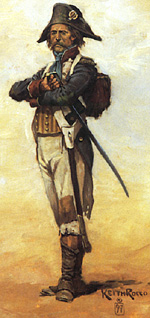 In 1786, the French military introduced sweeping uniform changes that continued to form the basis of much of the French line and light infantry uniforms for the next 26 years. However, as with almost all new uniform regulations, there was a degree of laxity even before the Revolution that included variations in cuff slashes, different flaps, all with varying degrees of piping on these items as well as on both high and low collars. With the advent of the Revolution, the number of uniform variations exploded.
In 1786, the French military introduced sweeping uniform changes that continued to form the basis of much of the French line and light infantry uniforms for the next 26 years. However, as with almost all new uniform regulations, there was a degree of laxity even before the Revolution that included variations in cuff slashes, different flaps, all with varying degrees of piping on these items as well as on both high and low collars. With the advent of the Revolution, the number of uniform variations exploded.
Regardless of the regimental variations, the traditional color of the French infantry was white with regimental facing colors borne on the collar, cuffs, lapels, and turnbacks. This uniform/facing scheme among the units of the established army was maintained as best as possible until the first amalgame [see sidebar on opposite page]. According to one contemporary artist, the white uniforms could still be seen sprinkled among the ranks as late as 1799.
What, then, was the new "national colors" uniform that replaced the traditional white coat? The great expansion of the Revolutionary armies as brought about by the volunteers of 1791, the volunteers of 1792, and the levee en masse of 1793 saw the need for a vast increase in the number of uniforms. With these new men and their uniforms came the replacement of the old white coats. That colorless habit was, to most Republicans, synonymous with the lifeless and deposed Bourbon dynasty whose legacy was to be erased with the reborn nation. In place of the white coasts with regimental facing colors, the Revolutionaries decreed that their army was to wear a new habit made from the "national colors" of red, white and blue.
Artist Keith Rocco's French Revolutionary line infantry officer accurately depicts the typical look of the demi-brigades de bataille (line infantry) of Bonaparte's ragtag Army the 1786 regulations, modified according to the "national colors." The habit is regulation blue, with scarlet collar and cuffs that are edged in white piping. The half-gaiters and trousers are also regulation, with the realistic touch of an added knee patch that typified the scarecrow look of most of the regiments. Beyond those items, the majority of the remaining clothing are non-regulation, including the scarf and civilian vest.
The hat worn by the officer is the famous bicorn that was proscribed by the 1786 regulations, and which was worn by most of the French line officers throughout the Revolution and well into the Empire. Naturally, Rocco shows the Republican officer displaying on his hat a tricolor cockade in concentric circles of red, white and blue in place of the white cockade that was discarded along with the other reminders of the ancien regime.
More Army of Italy 1796-1797:
-
Instrument of Victory
Map: Pursuit: 10 March to 6 April 1797 (Large very slow: 173K)
Map: Pursuit: 10 March to 6 April 1797 (Jumbo extremely slow: 369K)
Unit Profiles: Line Infantry
Unit Profiles: Light Infantry
Unit Profiles: Cavalry
French Revolutionary Line Officer
French Army Amalgames
Units under arms: Line infantry (Large Chart: very slow: 189K)
Units under arms Line infantry (Jumbo Chart: extremely slow: 561K)
Units under arms: Light infantry/Cavalry (Large Chart: very slow: 188K)
Units under arms: Light infantry/Cavalry (Jumbo Chart: very slow: 539K)
The 200th Anniversary Series on Napoleon in Italy
-
First Installment: Side Road To Immortality
Second installment: The Supporting Cast
Third installment: Maintaining the Initiative
Fourth installment: General Bonaparte Defends His Conquests
Fifth installment: Napoleon Turns Defeat into Victory
Sixth installment: One Final Victory: Rivoli
Seventh installment: Endgame: The Pursuit to Final Victory
Eighth installment: Instrument of Victory: Army of Italy
Back to Table of Contents -- Napoleon #9
Back to Napoleon List of Issues
Back to MagWeb Master Magazine List
© Copyright 1997 by Emperor's Press.
This article appears in MagWeb (Magazine Web) on the Internet World Wide Web.
The full text and graphics from other military history magazines and gaming magazines are available at http://www.magweb.com